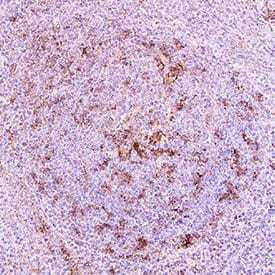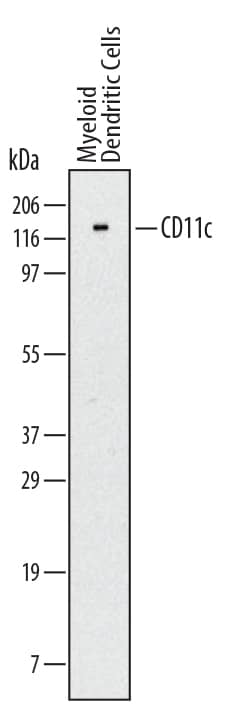Human CD11c Antibody
R&D Systems, part of Bio-Techne | Catalog # MAB17771

Key Product Details
Species Reactivity
Validated:
Cited:
Applications
Validated:
Cited:
Label
Antibody Source
Product Specifications
Immunogen
aa 20-1107
Accession # P20702
Specificity
Clonality
Host
Isotype
Scientific Data Images for Human CD11c Antibody
Detection of Human CD11c by Western Blot.
Western blot shows lysates of human mature myeloid dendritic cells. PVDF Membrane was probed with 2 µg/mL of Mouse Anti-Human CD11c Monoclonal Antibody (Catalog # MAB17771) followed by HRP-conjugated Anti-Mouse IgG Secondary Antibody (Catalog # HAF007). A specific band was detected for CD11c at approximately 150 kDa (as indicated). This experiment was conducted under reducing conditions and using Immunoblot Buffer Group 1with 0.05% Tween® 20 in the blotting buffer.Detection of CD11c in human tonsil.
CD11c was detected in immersion fixed paraffin-embedded sections of human tonsil using Mouse Anti-Human CD11c Monoclonal Antibody (Catalog # MAB17771) at 0.5 µg/mL for 1 hour at room temperature followed by incubation with the Anti-Mouse IgG VisUCyte™ HRP Polymer Antibody (Catalog # VC001). Before incubation with the primary antibody, tissue was subjected to heat-induced epitope retrieval using VisUCyte Antigen Retrieval Reagent-Basic (Catalog # VCTS021). Tissue was stained using DAB (brown) and counterstained with hematoxylin (blue). Specific staining was localized to cell surface in lymphocytes. View our protocol for IHC Staining with VisUCyte HRP Polymer Detection Reagents.Applications for Human CD11c Antibody
Immunohistochemistry
Sample: Immersion fixed paraffin-embedded sections of human tonsil
Western Blot
Sample: Human mature myeloid dendritic cells
Formulation, Preparation, and Storage
Purification
Reconstitution
Formulation
Shipping
Stability & Storage
- 12 months from date of receipt, -20 to -70 °C as supplied.
- 1 month, 2 to 8 °C under sterile conditions after reconstitution.
- 6 months, -20 to -70 °C under sterile conditions after reconstitution.
Background: CD11c
CD11c, also known as Integrin alphaX, is an approximately 150 kDa type I transmembrane glycoprotein that heterodimerizes with Integrin beta2, also known as CD18. The CD11c/CD18 complex, also called CR4 (complement receptor type 4) is expressed on macrophages, dendritic cells and hairy cell leukemias, with lower amounts on other myeloid cells and activated B, NK and some cytotoxic T cells. It binds fibrinogen and has been reported to be a receptor for complement component iC3b (1‑3). The human CD11c extracellular domain (amino acids 20-1107) shares 70 - 76% amino acid sequence identity with mouse, rat and canine CD11c.
References
- Hogg, N. et al. (1986) Eur. J. Immunol. 16(3):240.
- Knapp, W.B. et al. eds. (1989) Leukocyte Typing IV: White Cell Differentiation Antigens, Oxford University Press, New York.
- Stacker, S.A. and T.A. Springer, J. Immunol. (1991) 146(2):648.
Alternate Names
Gene Symbol
UniProt
Additional CD11c Products
Product Documents for Human CD11c Antibody
Product Specific Notices for Human CD11c Antibody
For research use only

